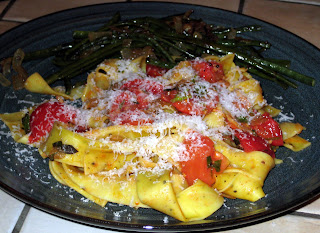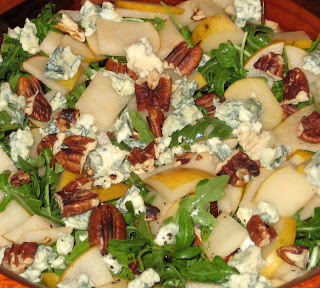This is one of those everything-but-the-kitchen sink recipes that can be made with whatever you have on hand. Luffa squash appeared in our CSA box this week, but Japanese eggplant would make a good substitute. If you have spinach or Chinese cabbage, chop some and throw it in. If you don't have curry leaves, add a bit more ginger and cilantro to keep it flavorful; if you don't have cilantro, increase or substitute something else. In other words, adjust all proportions to taste and switch things out for whatever strikes your fancy. But definitely call it Luffa Noodles at least once, out loud, because you'll feel instantly and delightfully transported into the midst of a Dr. Seuss book. (It really can't be helped. Consider: If you quickly turn the corner near the farthest side of town/and follow Horton's footprints down the block and then around/the Christmas-stealing Grinch who sometimes suntans on his stoop/you can often join the Lorax for some Luffa Noodle Soup.)
Ingredients
2/3 package soba noodles (typically, two of the three bundles in a package)
1/2 large yellow onion, chopped
Several fresh curry leaves
A spoonful of black mustard seeds A spoonful of good-quality medium curry powder
A few thin slices of fresh ginger, julienned
2 luffa squash, peeled and cubed (you can also cook it without peeling it, but we decided we liked it a little better without)
 |
| Luffa Squash |
Some shiitake mushrooms (or oyster, or enoki), brushed and cut into wide slices
A few long beans, cut into 1-inch pieces
1 cup chicken or veggie broth
1 egg
Freshly ground black pepper
Small handful cilantro leaves, coarsely chopped
A handful of pea shoots or bean sprouts, for garnish
Boil the noodles one minute less than directed on the package, drain, and set aside.
Heat some olive oil in a big pan over medium-high heat. Add the curry leaves and mustard seeds and stir for 15-20 seconds, then add the onion and cook until soft, turning the heat down to medium. Push onion to the side of the pan, add a bit more olive oil on the other side, then add a spoonful of curry powder to the oil, stirring to toast for a few seconds. Combine with the onion, add the ginger and saute for a minute, then add any vegetables that take a little longer to cook (the luffa squash, in this case). Stir and cook for awhile, covering the pan if it starts to dry out to create a little more liquid (you can also sprinkle a little salt on the vegetables to encourage them to release a little water). After awhile, add the mushrooms and beans, and continue cooking until tender. Sprinkle with some chopped cilantro and pepper, and turn off the heat.
Meanwhile, in a small pot, heat the chicken broth until it simmers. Add the soba noodles, bring back to a simmer, and then add the egg to the center of the pot. Turn off the heat, and fold a few noodles over the egg so that it's immersed. After 30 seconds or so, stir to break the yolk and let it cook into the broth.
Serve in layers: Noodles, then veggies, and top with a few sprouts and a bit more cilantro if desired.
 This post, though, is about pasta. Trader Joe's has this lemon pepper pappardelle that has relatively few ingredients (all recognizable), despite being processed enough that it can't really count as a whole food. But it's really, really good. And not every night can be a cook-everything-from-scratch night.
This post, though, is about pasta. Trader Joe's has this lemon pepper pappardelle that has relatively few ingredients (all recognizable), despite being processed enough that it can't really count as a whole food. But it's really, really good. And not every night can be a cook-everything-from-scratch night.












